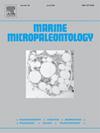西澳大利亚西南部250公里海域的古海洋学和海洋生态系统;来自纳米化石组合的见解
IF 1.5
4区 地球科学
Q2 PALEONTOLOGY
引用次数: 0
摘要
冰期-间冰期旋回期间的纳米化石波动揭示了古生态系统对气候和海洋变化的响应。本研究对Mentelle盆地(西澳大利亚西南部近海)的IODP孔U1516B的纳米化石组合进行了研究,该盆地受西澳大利亚洋流(WAC)、Leeuwin潜流(LUC)、Leeuwin洋流(LC)及其漩涡的影响。利用纳米化石计数、多样性指数和250天以上的有机地球化学,本研究评估了环流变化如何影响群落和生产力。结果显示,与西澳大利亚近海100公里的宽度不同,LC在Leeuwin角向西延伸200公里的漩涡中占据主导地位。在冰期,尽管深Florisphaera prounda的持续存在表明LC的影响较弱,但通过小的placoliths华来评估,LC减弱了。总有机碳(TOC)与氮(TN)呈中等相关性,冰川TOC值略高反映生产力增强。碳氮比(C/N >;12)为海陆混合有机质。在冰期,纳米化石丰度下降,可能是由于风沙或大量陆源输入,而多样性上升,表明群落分布均匀。间冰期丰度高,多样性低,以深角藻为主。这些趋势将LC强度与生态系统结构联系起来,在间冰期LC抑制上升流,有利于富营养化类群(如f.l udunda),而在冰期,LC减弱允许WAC和luc驱动的混合,提高生产力和多样性。这些发现强调了在冰期-间冰期旋回的驱动下,海洋环流和生产力是如何改变历史生态系统的。类似的动态可能影响未来生态对气候变化的反应,特别是在变暖改变当前系统的情况下。本文章由计算机程序翻译,如有差异,请以英文原文为准。
Paleoceanography and marine ecosystem over 250 ky offshore Southwest Western Australia; Insight from nannofossil assemblages
Nannofossil fluctuations during glacial-interglacial cycles reveal paleo-ecosystem responses to climatic and oceanic changes. This study examines nannofossil assemblages from IODP Hole U1516B in the Mentelle Basin (offshore southwest Western Australia (SWWA)), a region influenced by the Western Australian Current (WAC), Leeuwin Undercurrent (LUC), Leeuwin Current (LC), and its eddies. Using nannofossil counts, diversity indices, and organic geochemistry over 250 ky, this study assesses how circulation shifts impacted communities and productivity. Results reveal LC dominance through its eddies, extending >200 km westward offshore at Cape Leeuwin, unlike the 100 km width in offshore Western Australia. During glacials, LC weakened, assessed by small placoliths blooms, although persistence of Florisphaera profunda indicates weak LC influence. Total organic carbon (TOC) and nitrogen (TN) exhibit a moderate correlation, with slightly higher glacials TOC values reflecting enhanced productivity. Carbon‑nitrogen ratios (C/N > 12) suggest mixed marine-terrestrial organic matter. Nannofossil abundance declines during glacials, likely due to aeolian or high terrigenous input, while diversity rises, indicating evenly distributed communities. Interglacials show high abundance but low diversity, dominated by F. profunda. These trends link LC strength to ecosystem structure, where during interglacial LC suppresses upwelling, favoring oligotrophic taxa like F. profunda, whereas during glacials, LC weakening permits WAC and LUC-driven mixing, boosting productivity and diversity. These findings emphasize how oceanic circulation and productivity shifts, driven by glacial-interglacial cycles, structured historical ecosystems. Similar dynamics may influence future ecological responses to climate change, particularly as warming alters current systems.
求助全文
通过发布文献求助,成功后即可免费获取论文全文。
去求助
来源期刊

Marine Micropaleontology
地学-古生物学
CiteScore
3.70
自引率
15.80%
发文量
62
审稿时长
26.7 weeks
期刊介绍:
Marine Micropaleontology is an international journal publishing original, innovative and significant scientific papers in all fields related to marine microfossils, including ecology and paleoecology, biology and paleobiology, paleoceanography and paleoclimatology, environmental monitoring, taphonomy, evolution and molecular phylogeny. The journal strongly encourages the publication of articles in which marine microfossils and/or their chemical composition are used to solve fundamental geological, environmental and biological problems. However, it does not publish purely stratigraphic or taxonomic papers. In Marine Micropaleontology, a special section is dedicated to short papers on new methods and protocols using marine microfossils. We solicit special issues on hot topics in marine micropaleontology and review articles on timely subjects.
 求助内容:
求助内容: 应助结果提醒方式:
应助结果提醒方式:


